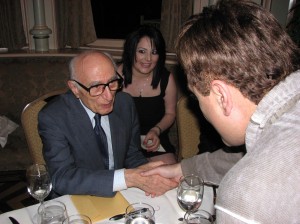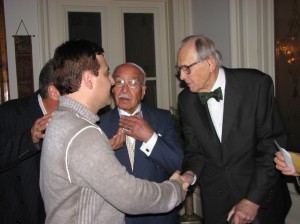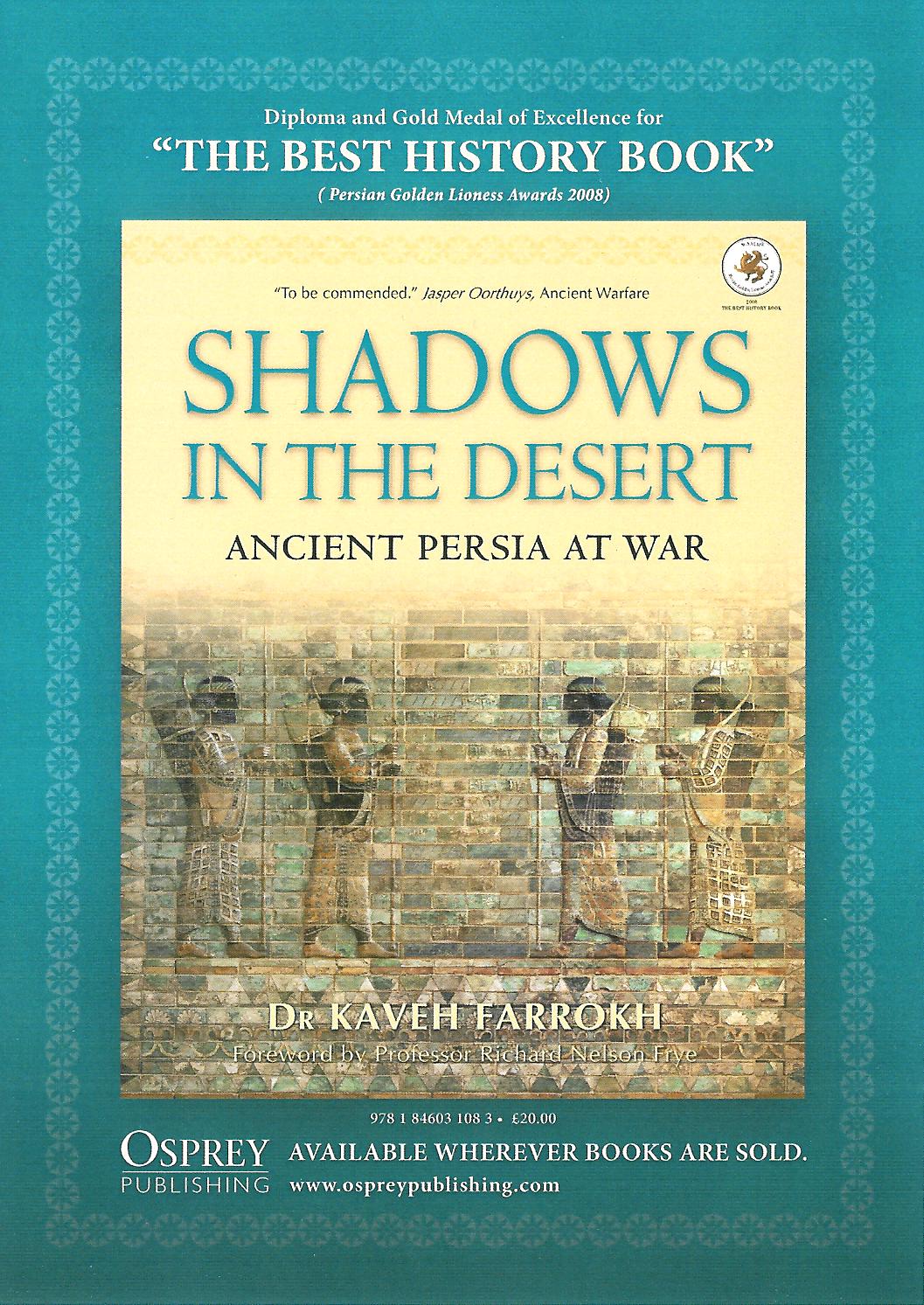Iranshenasi: A journal of Iranian Studies is one the most highly respected peer-reviewed journals of Iranian Studies and features an advisorry board of Iranian Studies scholars of the highest calibre. The chief editor of this journal is the distinguished Dr. Jalal Matini who has worked for decades to ensure the publication of articles pertinent to Iranian culture, history, society and the state of Iranian Studies programs in academia. Dr. Matini was the President of Ferdowsi University in Mashhad before the 1979 revolution.

Dr. Jalal Matini (standing at podium), the Chief Editor of the Iranshenasi journal flanked by the late Iranian poet and thinker, Nader Naderpour (seated at left) at UCLA.
The iranshenasi journal also utilizes first-class academics in the field of Iranian Studies to review recent books and publications. Dr. William L. Hanaway (University of Pennsylvania) is the Associate editor with Professor Emeritus Roger M. Savory of the University of Toronto being a member of Iranshenasi’s Advisory board.
The recent Iranshenasi edition features the following book review by Farhad Mafie of California State University (Fullerton):
==================================================
Introduction & the State of Iranian Studies Programs
Below are some select quotes from Mafie’s introductiory observations:
“Fortunately, more and more first- and second-generation Iranian scholars, archaeologists, and researchers in the West have shown great interest in…studying ancient Persia…faciliated some serious scholarly works on Iran’s pre-Islamic eras, in spite of the lack of financial support nad many other limitations” (Mafie, 2010, pp.1).
Mafie’s reference to the “lack of financial support and many other limitations” is very astute and to the point. Professor Ehsan Yarshater, the editor of the Encyclopaedia Iranica, noted in an interview with the Gooya News Service on June 6, 2004 that:
“…the total number of competent scholars in Iranian Studies is decreasing…the number of young scholars drawn to Iranian Studies has become alarmingly low…the one exception is Italy…”.
Since that interview, Iranian studies in Italy have been threatened by the possible closure of the Istituto Italiano per l’Africa e l’Oriente .

Professor Yarshater meets Farrokh during the Persian American Society’s honoring ceremonies for Professor Emeritus Richard Nelson Frye on March 1, 2008. It was during one of the key speeches at this event when Professor Yarshater raised alarm with respect to anti-Iran historical revisionists and the dangers of insufficient support for Iranian Studies in the West.
==================================================
Evaluation
Mafie has provided a number of points evaluating Farrokh’s text. Four of these are cited below’:
“Even though the book obviously focuses on the history of warfare and armaments during the Achaemenid, Parthian and Sassanian Empires, Farrokh metioculously analyzes the cultural, political and religious aspects of each period and he shows how they are all interwoven and how they have impacted each war and its aftermath” (Mafie, 2010, pp.2).
“To his credit, while he shows the glories of the Persian Empires, he makes objective assesments of the events and their consequences…based on the historical evidences ” (Mafie, 2010, pp.3).
“Even if one does not have the time to read this wonderful and informative book in its entirty…Chapter 19 (“The Legacy of Persia after the Islamic Conquest”) must be read, especially by all young Iranians interested in learning about Sassanians’ and Iran’s impact throughout history upon civilizations around the world…Chapter 19 could be expanded to a separate volume… ” (Mafie, 2010, pp.4).
“The book contains a very useful chronology and a comprehensive bibliography of both primary and secondary sources, which help the reader to find the desired relevant references much faster. In addition to a comprehensive index, Farrokh provides an excellent Endnotes section that offers further explanations, references and relevant information on various key points in each chapter. A great help to students! ” (Mafie, 2010, pp.4).
==================================================
Recognition
Mafie has made reference to the text’s recognition by noting that:
“Shadows in the Desert: Ancient Persia at War received the “Best History Book of 2008 Award” in the London WAALM (the World Academy of Arts, Literature, and Media) ceremonies in November 2008. It has also been selected as among the top three history books of 2008 by the Independent Book Publishers Association of the United States” (Mafie, 2010, pp.4).
Farrokh at the WAALM ceremonies of November 2008.
==================================================
Conclusion Notes
Mafie has referred to the text as a reference source at the post-secondary level:
“Many historians in major universities…have selected this outstanding volume…I am sure more and more universities and colleges will be adopting Farrokh’s book once they have had the opportunity to read and examine this informative volume for themselves” (Mafie, 2010, pp.5).

Meeting his mentors: Farrokh greets Professor Emeritus Richard Nelson Frye of Harvard University(shaking hands with Farrokh) and world-renowned Iranologist, Dr. Farhang Mehr (at center), winner of the 2010 Merit and Scholarship award (photo from Persian American Society,March 1, 2008). As noted by Mafie, Professor Frye of Harvard University wrote the foreword of Farrokh’s text stating that “…Dr. Kaveh Farrokh has given us the Persian side of the picture as opposed to the Greek and Roman viewpoint …it is refreshing to see the other perspective, and Dr. farrokh sheds light on many Persian institutions in this history…” (Mafie, 2010, pp.2).
Mafie conludes that:
“I highly recommend this wonderful bookl to anyone who is interested in learning about pre-Islamic Iranian history…and how the legacy of the Persian Empires continues in today’s world (Mafie, 2010, pp.4)…this book is not limited to textbook use or to scholarly studies. Everyone who is interested in world history will enjoy this volume…” (Mafie, 2010, pp.5).




